ISSN ONLINE(2319-8753)PRINT(2347-6710)
ISSN ONLINE(2319-8753)PRINT(2347-6710)
Abdul Samad P.A.1, Sandeep K. 2, Dr. Shalij P. R.3
|
| Related article at Pubmed, Scholar Google |
Visit for more related articles at International Journal of Innovative Research in Science, Engineering and Technology
Ceramic particles suspended in Aluminum melts for vertical centrifugal casting of Functionally Gradient Composite (FGC) have been studied. Force balance on ceramic particles is formulated and motion of ceramic particles in viscous molten metal under centrifugal force and drags force has been modeled. Effects of solidification were incorporated. MATLAB is used to simulate the process of gradient composition formation in vertical centrifugal casting of Aluminum Silicon Carbide composite. Effect of various parameters like mold rotational speed, solidification rate and initial partial fraction of particle on segregation of particle is examined.
Keywords |
| Centrifugal Casting, Functionally Gradient Composite, Particle Segregation, Aluminum Silicon Carbide Composite |
INTRODUCTION |
| Functionally gradient materials (FGM) are characterized by continuous and smooth variations in compositions and/or microstructure so as to meet functional performance requirements that vary with location within a part. Among various FGMs, metal-ceramic FGMs, also called functionally gradient composites (FGC) are of great practical interest. FGCs are epitomized by gradual compositional variation from metal concentrated region at one area to ceramic concentrated region at another. This leads to mechanical physical and/or chemical properties across the thickness. The advantage is minimized stress concentration at the interface of dissimilar materials.FGCs are finding applications in aggressive environments with steep temperature gradients such as rocket nozzles, thermal barrier coatings, turbine component etc. It has also found its application in some automobile components. |
| Some methods of producing FGMs are solidification processing, chemical vapour deposition, powder metallurgy etc. But none of them are suitable for mass production of large components. Centrifugal casting is a relatively new method to produce functionally gradient composites by varying process parameters. The technique involves pouring a liquid melt containing reinforcement ceramic particles into a rapidly rotating mold which is mounted either vertically or horizontally, and continuing the rotation until solidification is complete. During rotation, segregation of particle occurs due to centrifugal force either to inner or outer part of casting depending on relative densities of particle and melt, resulting in particle reinforced FGC. The extend of segregation depends on the process parameters like particle size, mold rotational speed and initial partial fraction of particle. |
RELATED WORK |
| P. Samba Siva Raju et al.[1] proposed a mathematical model to find the particle motion in centrifugal casting of metal ceramic composite. The proposed model is simulated and results show that rotation speed has good effect over the gradient formation. Prem E J Babu et al.[2] described in their paper that when centrifugal force is applied on casting, it allows control of the particle distribution in a metal matrix during solidification and becomes an important and fruitful technology for production of cast parts with graded structures and properties. Segregation of the solid particles dispersed in liquid rotating slurry occurs owing to centrifugal force. Particles are moved either to the outer or the inner part of rotating mould because of their density difference with the melt. |
| There are different approaches for the description of the physical interactions, which take place in this complex of phenomena characterizing centrifugal casting of particle reinforced composites. Almost all models existing at present are one-dimensional because of simplicity and the fact that centrifugal acceleration is much greater than gravity [3,4]. Almost all studies till date uses a simple first degree differential equation as dynamic equation except the model by Prem E. J. Babu, T.P.D. Rajan, S. Savithri, U.T.S. Pillai and B.C. Pai [2]. The dynamic equation is essentially a second order differential equation because of the centrifugal acceleration. But The thickness of the particle rich zone at the two ends of a casting (top and bottom, or the front and rear parts of a centrifugally cast cylinder) is very often larger than the same zone in the central part of casting in case of a horizontal centrifugal casting [3]. So the case is essentially two dimensional in horizontal |
MODELING OF FORCES ACTING ON PARTICLE |
| Particles in a metal molt will be acted on by centrifugal, gravity and drag forces and the interaction between the particle and the interface of the particle movement (solidification front). The following assumptions are made for modeling: |
| ïÃâ÷ Ceramic particle is spherical in shape |
| ïÃâ÷ The pouring melt is having uniform distribution of particle suspended in molten metal |
II.A. Centrifugal Force |
| During centrifugal casting, particle segregation occurs owing to difference in densities between the molten metal and the particles. Assuming spherical particles, the total centrifugal force is given by |
| r is the radial distance of the particle from axis of rotation, N is the rpm of rotation, Rp is the radius of particle. |
II.B Drag force |
| In the case of flow over a sphere, both friction drag and pressure drag (form drag) contribute to total drag. Stokes reported that for a symmetric flow field with small velocities (Re < 0.1), the dominant force on the sphere is viscous and the inertial term in the momentum equation can thus be neglected. The expression given by Stokes is |
| where, μ is the kinematic viscosity of the fluid material. It is known that the viscosity of the melt increases according to the increase in number of particles in the suspension. The viscosity of a melt containing particles is given by [1, 2] |
 |
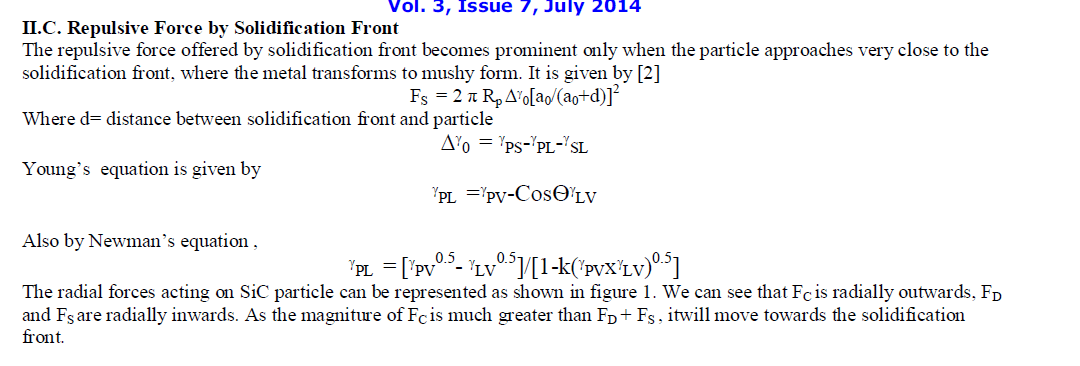 |
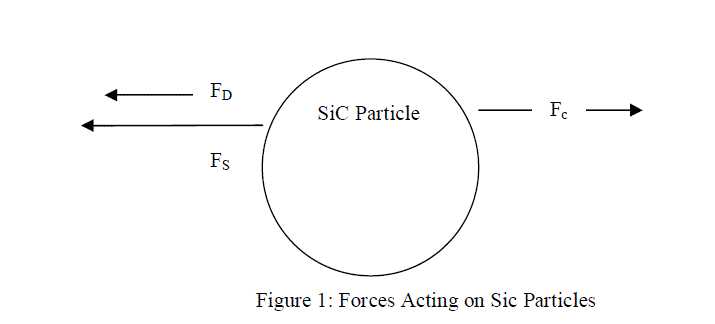 |
| Thus the dynamic equation of particle is given by |
| We are considering a cylindrical mold of diameter 100mm. In order to understand the particle distribution up to the centre of rotation (centre of casting); we are casting a solid cylinder. This consideration eliminates the necessity of high rotating speeds so that we can get thicker particle rich regions resulting in more functionally gradient materials. When the particle touches the wall, it stops and the position of particle at this moment is the final position of particle. We have to find final position of all 10 particles mentioned above from 0.005 to 0.05. Particle at 0 will not move radially, as it will not experience any centrifugal force. |
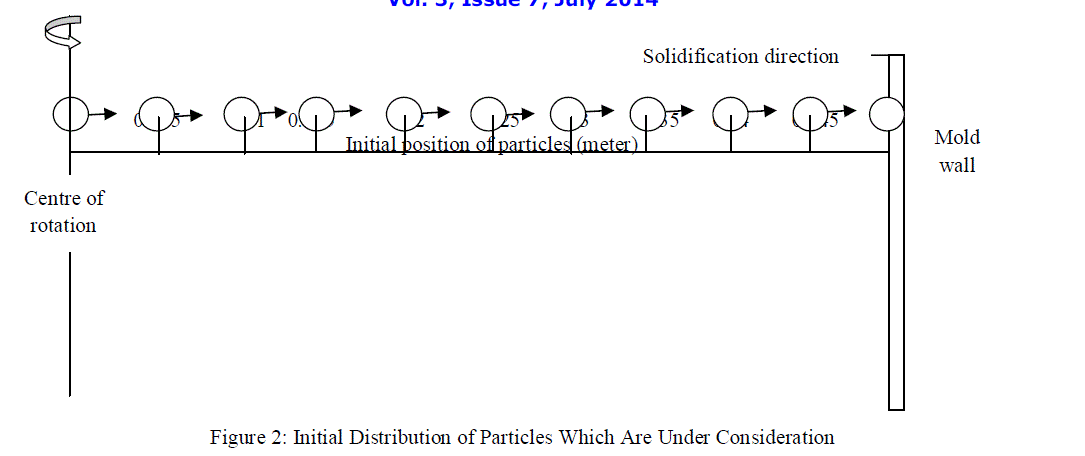 |
RESULTS AND DISCUSSION |
III.A. Effect of mold rotation speed |
| Concentration gradient at mold rotation speeds of 400rpm, 800rpm and 1200rpm are simulated in MATLAB and results are plotted as below. Other parameters are particle volume fraction of 0.1, solidification rate of 10 microns/s, particle size of 40 microns. |
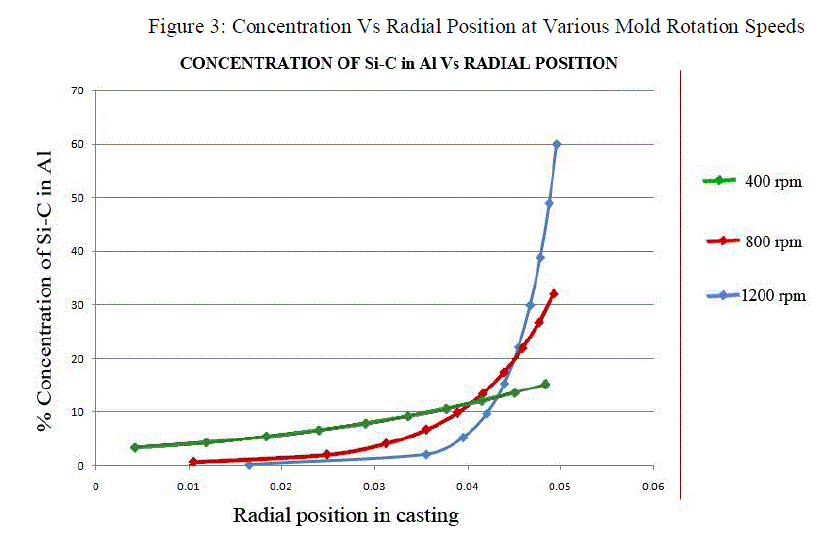 |
| From figure 3 we can see that final position of particle with initial position at 0.005 when process at 800 rpm, gave a result of 21mm radially from centre of casting. When we reduce the rotation speed by 50%, ie to 400 rpm, it reduces the penetration by 62%. When we increase the rpm by 50 %, it increases the penetration to the periphery by 57%. This shows that the process offers a good control over the distribution of SiC particles in Al matrix. This is contributed by the density ratio of Al and SiC. So Al-SiC composition is very suitable for molding functionally gradient parts. |
| While looking at the concentration of Si-C at various positions radially, we can see that at 1200 rpm, it goes too high at periphery, and almost zero near the centre up to 15mm from centre. More than 35% concentration of the SiC in wt/wt will result in poor micro structure. Al matrix will be weak and property of such a part may be undesirable. At 800 rpm concentration lies well under 35% , which is allowable. Further looking at the values of concentration, we can see that at around 10mm depth from periphery it reaches the 10% concentration and further down to almost 0% around 0.01 from centre. On looking at the graph of 400 rpm, concentration varies more in a linear way compared to higher rpm. Also the maximum concentration at periphery is only 15% . 10mm away from centre it comes to 3.5%. |
III.B. Effect of Solidification Rate |
| Solidification rate, varies with the type of mold material, number of layers of mold, convection type, shape of the mold etc. For cylindrical mold the rate of solidification is assumed to be constant. It may vary from 9 microns/s to 70 microns/s radially inwards, starting from outer surface of the casting. In order to understand the effect of solidification rate, we are considering 2 solidification rates: 10 microns/s and 20 microns/s. Plot shown below is at 800 rpm mold rotation speed, other parameters same as previous plot. |
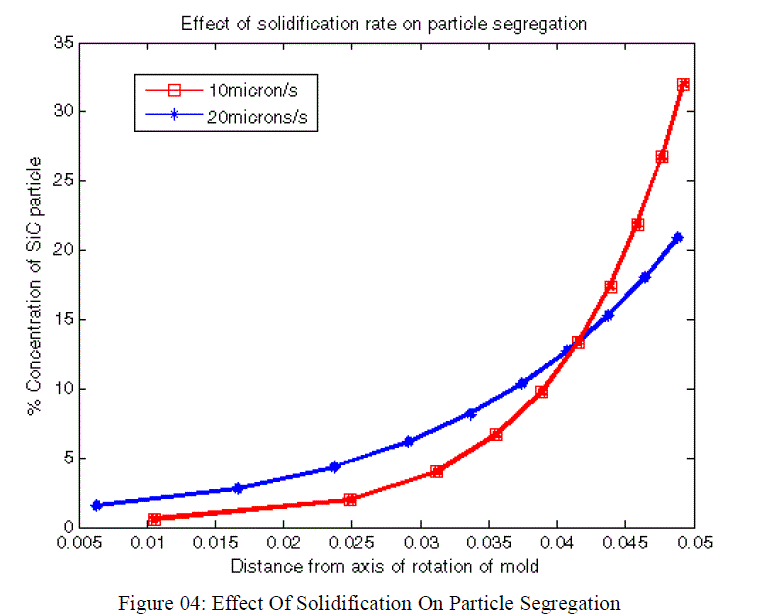 |
| From figure 4, we can observe that as the solidification rate doubles, 37% decreases occur to the particle concentration at the surface. There is a clear decrease in segregation effect as the solidification rate increase. Solidification rate cannot be controlled much for a specific centrifugal casting set up, but cooling rate, insulation etc may help in this regard. |
III.C. Initial Partial Fraction of Particle in Melt |
| Initial partial fraction affects viscosity of the melt, thus influence on drag force experienced by each individual particle. The expected result is lowering the segregation of particle. Also it gives rise to overall concentration increase, which may be experienced throughout the thickness of casting. |
| From figure 5 we can observe that, effect of drag force variation is very small as compared to the overall particle concentration increase. So we can say that as initial particle concentration doubles, the overall concentration also gets almost doubled. Effect of viscosity change may be neglected. Other parameters are 800 rpm mold rotation speed, 40 microns particle size, 10 microns/s solidification rate. |
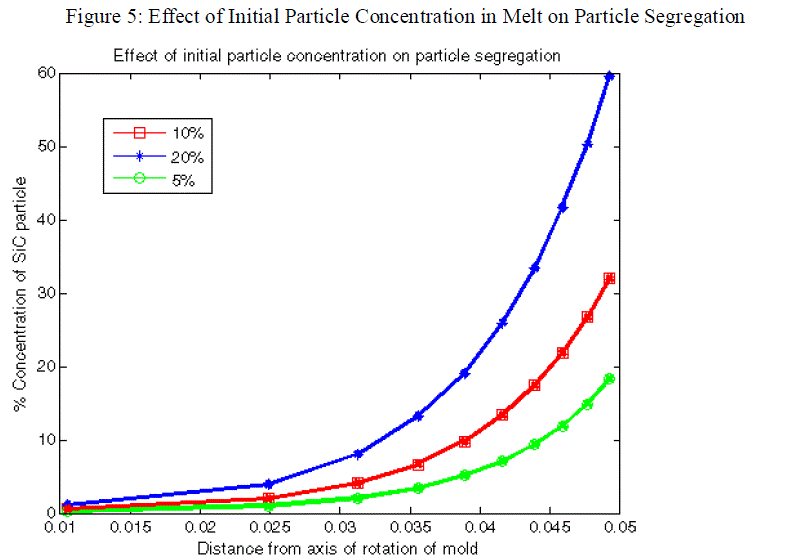 |
CONCLUSION AND FUTURE ENHANCEMENT |
| Mold rotational speed directly affects the particle concentration gradient, so is the solidification rate. Hence both are good parameters to control particle segregation. But once the centrifugal casting machine set up is made, solidification rate is difficult to change for that particular machine, unless otherwise it has some convection control feature. Initial particle concentration helps in increasing the particle concentration throughout the casting but do not contribute much to particle segregation. The experimental validation of this simulation is not yet completed. The required experimental set up are stir casting machine (in order to get a uniform mixing) and a vertical centrifugal casting set up with convection control. Also influence of other parameters like mold pre heating, particle size etc can be experimented. |
APPENDIX |
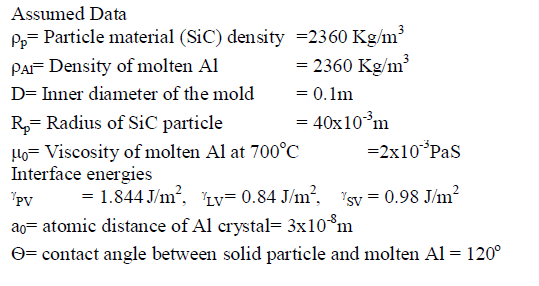 |
References |
|